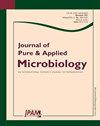Isolation of α-Amylase Producing Microorganisms from Soil of Kachchh, Gujarat
IF 0.7
Q4 MICROBIOLOGY
引用次数: 0
Abstract
The purpose of this study is to explore the soil of the Gujarat, Kachchh region to identify amylase-producing bacteria and characterize them using molecular methods. The unique ecological characteristics of the Kachchh region may facilitate the isolation of these bacteria. Samples were collected from multiple locations within the Kachchh District, including Gandhidham, Rapar, Bhuj, Nakhatrana, Mandvi, and Mundra Talukas. These samples were then screened to isolate amylase-producing bacteria. A total of 27 different types of colonies were identified, out of which 16 exhibited amylase production (M1-M16). Out of 27 colonies identified, 16 showed amylase production. Strains M2, M7, and M13 exhibited high amylase activity, with M2 showing a consistent increase over 72 hours, making it a strong candidate for amylase production. Further identification of M2 stain identified M2 as a Gram-positive, spore-forming, capsulated, and motile bacillus, specifically Bacillus licheniformis. This was confirmed through DNA sequencing and analysis in the NCBI database, which showed a 99.15% similarity with Bacillus licheniformis. The study concludes that Soil in Kachchh is rich with microorganisms that produce amylase, an enzyme with diverse industrial applications. These organisms are valuable for sectors like food, textiles, paper, detergents, pharmaceuticals, and biofuel production.从古吉拉特邦卡奇的土壤中分离出产α-淀粉酶的微生物
本研究的目的是探索古吉拉特邦卡奇地区的土壤,以确定产生淀粉酶的细菌,并使用分子方法描述其特征。卡奇地区独特的生态特征可能有助于分离这些细菌。研究人员从卡奇地区的多个地点采集了样本,包括甘迪德姆、拉帕尔、布吉、纳哈特拉纳、曼德维和蒙德拉塔卢克。然后对这些样本进行筛选,以分离出产淀粉酶的细菌。共鉴定出 27 个不同类型的菌落,其中 16 个菌落能产生淀粉酶(M1-M16)。在鉴定出的 27 个菌落中,有 16 个能产生淀粉酶。菌株 M2、M7 和 M13 表现出较高的淀粉酶活性,其中 M2 的活性在 72 小时内持续上升,是产生淀粉酶的有力候选菌株。对 M2 染色体的进一步鉴定发现,M2 是一种革兰氏阳性、孢子形成、有荚膜和运动的杆菌,特别是地衣芽孢杆菌。这一点通过 DNA 测序和 NCBI 数据库的分析得到了证实,该数据库显示 M2 与地衣芽孢杆菌的相似度为 99.15%。研究得出结论:卡奇的土壤中富含能产生淀粉酶的微生物,淀粉酶是一种具有多种工业用途的酶。这些微生物对食品、纺织品、造纸、洗涤剂、药品和生物燃料生产等行业具有重要价值。
本文章由计算机程序翻译,如有差异,请以英文原文为准。
求助全文
约1分钟内获得全文
求助全文
来源期刊

Journal of Pure and Applied Microbiology
BIOTECHNOLOGY & APPLIED MICROBIOLOGY-MICROBIOLOGY
CiteScore
2.00
自引率
0.00%
发文量
266
审稿时长
11 months
期刊介绍:
Journal of Pure and Applied Microbiology (JPAM) is a peer-reviewed, open access international journal of microbiology aims to advance and disseminate research among scientists, academics, clinicians and microbiologists around the world. JPAM publishes high-quality research in all aspects of microbiology in both online and print form on quarterly basis.
 求助内容:
求助内容: 应助结果提醒方式:
应助结果提醒方式:


